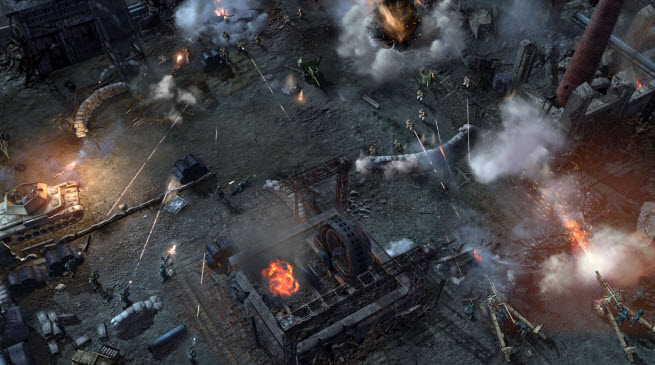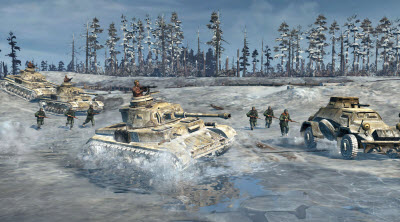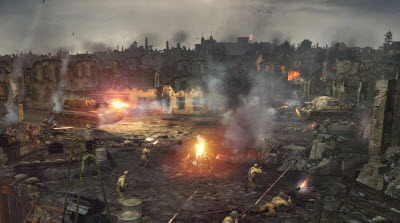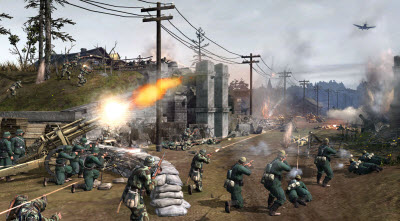 THQ’s Company of Heroes 2 is looking better and better with every veil that company lifts on this real-time strategy game set on World War II’s Eastern Front. Today, THQ’s Relic Entertainment is showing off multiplayer combat for the PC game that debuts early next year.
THQ’s Company of Heroes 2 is looking better and better with every veil that company lifts on this real-time strategy game set on World War II’s Eastern Front. Today, THQ’s Relic Entertainment is showing off multiplayer combat for the PC game that debuts early next year.
 Company of Heroes 2 takes places during the cruel cold winters and brief springs of the war, chronicling the start of the German invasion of Russia in 1941 until the Battle of Berlin at the war’s close. You can play either side, and it offers very cool features, such as blizzards that can kill your troops and destructible environments such as cracking ice on frozen rivers.
Company of Heroes 2 takes places during the cruel cold winters and brief springs of the war, chronicling the start of the German invasion of Russia in 1941 until the Battle of Berlin at the war’s close. You can play either side, and it offers very cool features, such as blizzards that can kill your troops and destructible environments such as cracking ice on frozen rivers.
I played a couple of rounds of the game. This was the third time I’ve seen it, and I must say I am looking forward to it. After all, it’s been six years since the original Company of Heroes came out, and we haven’t seen a really good real-time strategy game since StarCraft II: Wings of Liberty in 2010.
In the single-player campaign for Company of Heroes 2, you have to create your soldiers and send them out to take territory. Multiplayer’s gameplay is the same. But your opponents can be a lot smarter, because they’re human and therefore unpredictable. With this multiplayer version, Relic Entertainment tried to create matches that could really get your competitive juices flowing.
“We rewrote our creative vision for multiplayer,” said Quinn Duffy, the game director for Companies of Heroes 2 said in an interview with GamesBeat. “Our saying was ‘Every battle tells a story.’ These battles have their own little stories, and when we finish playing a battle, we get up and talk about the stuff that we did. It makes it feel like a more social experience. We embraced that wholeheartedly.'”
When you have two really well-matched players, Company of Heroes 2 should feel like a big struggle. As such, it is a fitting tribute to the horrible Eastern Front, where the Red Army and the Wehrmacht suffered more than 14 million military casualties. The horror of the war comes through in features such as storms that can freeze your troops, flamethrowers that send them screaming in pain, and ambushes that can take all of the morale out of your soldiers and leave them crawling on the ground. The Soviets are aggressive and have bigger squads, but they are not particularly well led. The Germans are hardcore veteran soldiers, with the advantage of having better weapons on almost every level. You can equip German infantry with antitank weapons that will stop Russian tanks cold.
In multiplayer, you can play one on one or as many as four against four. I was able to play a couple of 1-on-1 matches in the preview.
First blood in multiplayer
The multiplayer map was set during a winter campaign. As you start a multiplayer match, all you have is a team of engineers and a headquarters area. You start training soldiers, and they walk onto the battlefield as training is completed. To get more resources, you have to start taking territory.
In the first battle, I fought against fellow GamesBeat writer Kat Bailey. She was Russian, I was German. We were both equally inexperienced (after all, I hadn’t played Company of Heroes in six years). I had played the single-player version fairly recently and was able to get my production of soldiers going. I played the Germans and produced plenty of engineers, dubbed “pioneers” on the German side. I used the pioneers to upgrade my base so that I could produce half-track vehicles and large numbers of soldiers. Then I sent them out one by one to grab as many strategic spots as possible.
Those spots can earn you victory points, help you gain fuel, or get more ammo. My trick was the puff myself up as big as I could, to strike fear in Kat’s heart. As soon as we fought our first clash, I sent a bunch of soldiers into the battle from all directions. That made my army seem stronger than it was, and I was able to win the first battle. Company of Heroes 2 makes good use of the “fog of war,” where you can only see the enemies that are within the line of sight of your own troops. I took a watchtower, and that gave me extra visibility.
Duffy told me that the designers didn’t really want quick battles, but they also didn’t want maps that were so big that the first contact didn’t happen for a full five minutes. That’s just too boring.
Once we started fighting, I tried to develop a combined arms group, with machine gunners, a mortar crew, pioneers, and general infantry. I added half-tracks with machine guns, and I upgraded my pioneers to flamethrowers when I remembered that they could do that. I sent the main force into the center of the map, but I also kept the pressure on the enemy in all sections of the map. My machine gunners did a good job of stopping enemy attacks, but they didn’t last long on their own. The half-tracks, however, were pretty good at stopping infantry attacks.
What complicated the battle was the blizzard that swept through it on a couple of occasions. Company of Heroes 2 has an in-game weather mechanic made possible by Relic’s Essence Engine 3.0′s ColdTech system. You can play on the same maps in springtime weather when the terrain is green and brown or in the heart of winter when you have to deal with deep snow (which slows infantry down) or brutal subzero winds. At any given moment, a blizzard could start or stop. The snow has depth, and it can accumulate, blocking your view of what’s ahead. You can melt it and reduce it or get stuck in it. Rivers may freeze over, but they may crack under the pressure of heavy vehicles. The blizzard obstructs the vision of your soldiers. That’s bad, because you only see what your soldiers can see. And if you don’t get your soldiers to cover, they will die.
As the blizzard struck, I knew that my soldiers had to get to cover. I moved my soldiers into buildings or vehicles for warmth. But I had to send some pioneers to build fires that protected the soldiers at my headquarters. During this time, my opponent had the same problem. So combat came to a halt and surviving the weather — and building up forces — took over. I eventually took enough of the victory points on the map to put the squeeze on the enemy. At some point, Kat couldn’t send soldiers over to retake victory points that I had taken. And I eventually won.
Turning the tables
In the second battle, it was my turn to bleed. This time, I lost the first encounter and suffered setbacks. My rival was better at everything, including taking territory and building soldiers faster.
I made a mistake of signing up an artillery commander, rather than a tank commander, for my support. That slowed me down in the development of my armor capabilities, and this turned out to be a tank fight.
I tried to build up vehicles as quickly as I could, but I was constrained to building half tracks. As soon as I saw the enemy’s first Panzer tank appear, I knew I was finished. I built some anti-tank guns in response, but those were not very maneuverable, and they required a lot of infantry protection. And I was running out of soldiers.
The enemy hit me with a devastating attack by three T-34 tanks on my headquarters. Fortunately, I had an antitank gun nearby that put a stop to it. But my German infantry grenadiers had not upgraded to anti-tank weapons. Like in the real war, machine guns and rifles have no effect on an heavily armored tank.
Also, as Duffy pointed out, the bases themselves have defenses. I had a machine gun nest that stopped the enemy infantry. And machine gunners can pin down 100 soldiers as easily as they can pin done one. So it is possible to counter a surprise attack.
I rained down an artillery strike on the invader’s tanks. I had a Stuka dive bomber airstrike, but all I could really do was set the general direction of its attack. It circled around until it could find a target, but didn’t do much damage to the enemy tanks. It gives an umbrella of protection, but it doesn’t last forever. An antiaircraft tank can counter the Stuka.
I survived that assault on my headquarters, but it served its purpose of crippling my military unit production. Eventually, time ran out for me. The enemy took control of the three major strategic spots on the map and I couldn’t take them back. In the first game, everything went right for me. In the second game, played on the same map, everything went wrong.
Epic scale?
The multiplayer combat is wonderfully fun. You can find use different strategies to fight the same battle over the same ground. Does every multiplayer battle tell a story? Well, I felt compelled to tell you about mine, so I guess that’s true.
I have one nagging feeling I have about Company of Heroes 2. In some ways, the scale of the game is off. On the Eastern Front, you had huge battles. But in Company of Heroes 2, the size of each map is contained to a really small area. Tanks can’t fire at each other from a mile away. If the tanks get in a fight, it’s almost like a duel at point-blank range. That’s fine, but it’s not exactly realistic. The battle maps are about a half-kilometer square. That’s not huge, and it forces close combat.
This closeness isn’t a problem in ancient warfare games like Age of Empires, where you had hand-to-hand combat. I almost wish that there were a better way to zoom out to see a much larger battlefield, as you could with the “strategic zoom” of the Supreme Commander series of games. Still, this is where entertainment value trumps realism, and the nature of the game’s scope is fine, for a fun game.
Here’s a developer diary video from producer Greg Wilson, lead animator Brett Pascal, and lead campaign designer Jasen Torres.
VentureBeat's mission is to be a digital town square for technical decision-makers to gain knowledge about transformative enterprise technology and transact. Learn More


